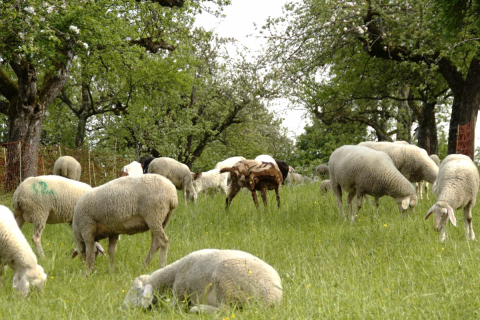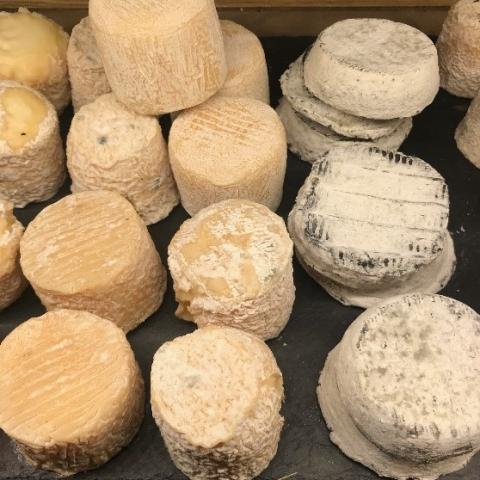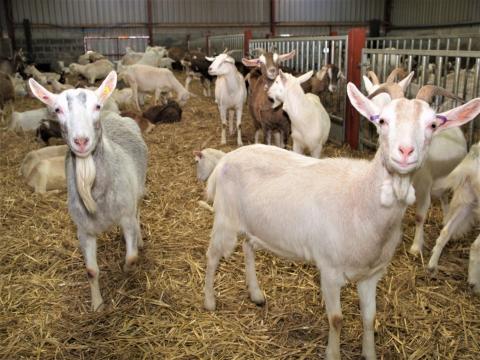25 June 2019
Dr Cate Williams: IBERS, Aberystwyth University.
- Bovine milk is the most popular and economically important type of milk in developed countries, including the UK.
- As consumers demand more diverse products and interest in speciality foods grows this leaves a niche for non-bovine milk (from sheep and goats).
- Sheep and goat milk is rich in a broad spectrum of vitamins and minerals and can be suitable for those suffering from a cow’s milk allergy.
Milk, in general, is a food of major global economic importance with recent research suggesting humans have been exploiting animal’s milk as a food resource as far back as the Bronze Age (3,000 BCE). Animal’s milk is an excellent nutritional resource, containing high levels of clean liquid, sugar, fat, B-vitamins and calcium. Humans have adapted behaviourally to milk consumption by developing techniques such as pasteurising and curdling and also biologically by evolving lactase persistence, a genetic adaptation which allows the digestion of lactose in milk. The consumption of milk and milk products varies from country to country, from Finland consuming 180 litres per capita to 50 litres in Japan and China. Liquid milk consumption in the UK is relatively high, measured at 102 litres per capita. Whilst bovine milk is the most predominant of dairy foods in the world, non-bovine (e.g. sheep, goat, donkey, reindeer, and camel) milk is also a key source of nutrition in some parts of the globe.
Milk and its uses
Milk is a versatile product that can be converted into different forms or used as an essential ingredient in the manufacture of many other foods. Key foods produced from milk include cheeses, yoghurts, cream, butter and probiotics.
The high levels of fat and protein found in cheese combined with its long shelf life made for an excellent source of nutrition in the past, however, in modern westernised diets there is a requirement to minimise saturated and trans fat intake. Cheese additionally offers essential nutrients such a protein, amino acids, lipids, vitamins and minerals and also contains some health-beneficial conjugated linoleic acids (CLA). The main influence on the properties of cheese is the type of milk that it is derived from – cheese from cow’s milk tend to be smooth, cheese from goat’s milk is often tart whilst cheese from sheep’s milk is rich and slightly sweet.
The same may be said of yoghurt, which can be manufactured from many different types of milk, although cow’s milk remains the most popular choice, goat’s milk is rising in popularity. Yoghurt from goat’s milk tends to be thinner than that from cow’s milk whilst that from sheep’s milk is thicker and creamier.
Furthermore, non-bovine milk, in particular, goat’s milk, is emerging as an effective ingredient for pro-biotics. Yoghurts from bovine milk tend to be the most common sources for commercial pro-biotic products containing live microorganisms that confer a health benefit to the consumer. Demand for pro-biotics based on non-bovine milk is increasing due to allergies, intolerances and interest in ‘healthier’ food in general. Both goat’s and sheep’s milk have been reported to contain higher levels of health beneficial unsaturated fatty acids than cow’s milk, with goat’s milk containing more zinc, iron and magnesium in addition to better digestibility. In testing, goat’s milk has proven effective in the manufacture of probiotics, maintaining the viability of microorganisms during storage and even enhancing their function. The main barrier preventing more widespread use of goat’s and sheep’s milk is its sensory properties, which for many consumers remain unappealing when compared to bovine milk.
Manipulating the qualities of ruminant milk
Much research has been directed into manipulating the quality of ruminant milk – predominantly of cow’s – be that via diet, ruminal interventions or genetic manipulation and selective breeding. The overarching aim of manipulation regardless of the methodology is to lower the level of detrimental saturated and trans-fats in milk and to enhance the health-beneficial polyunsaturated and CLA content for a healthier fat profile.
Extensive research has investigated the effect of dietary lipid supplements in a bid to manipulate the fat profile of milk, using plant seeds, oilseeds and ruminally protected lipid supplements. A meta-analysis evaluating the use of oilseeds in manipulating the fatty acid profile of milk found that less C16:0 (palmitic acid, a saturated fat) was observed under all treatments, with a subsequent increase in C18:0 (stearic acid, also saturated). Whilst both of these fatty acids are saturated, C18:0 is preferable as several studies have found that it has no effect on narrowing of the arteries (atherosclerosis) and actually decreases cholesterol levels, blood pressure and risk of cancer. However, the same study also found that the inclusion of plant oils or oilseeds in the diet did not significantly increase the content of polyunsaturated fatty acids (PUFA) in milk. It is thought that this is due to the rumen microbial population, as unsaturated, health beneficial fatty acids are toxic to them they work to convert them into safer, saturated fats.
Selective breeding for animals that produce higher quantities of milk or that of a different taste or texture has been used for thousands of years and has resulted in the evolution of the stereotypical Holstein-Friesian dairy cow we see today. The simple practice of breeding only animals displaying the required physical trait results in a population of animals that possess the genetic code giving rise to this physical advantage. An excellent example of this effect can be seen in Jersey milking cows, whose milk contains more protein, casein and fat and coagulates quickly making it suitable for cheese production. By comparison, Holstein-Friesian cows produce a higher quantity of milk overall, which is higher in health beneficial CLAs.
Nutritional composition of non-bovine milk
Small dairy ruminants (sheep and goats) currently produce 3.5% of the world’s milk and are mainly found in sub-tropical-temperate areas of Europe, Asia and Africa. Dairy sheep are most commonly found around the Mediterranean where their dairy products are key components of the human diet. Dairy goats are mostly found in low-income, food-deficit countries of India where their products are an important food source, although, the demand for non-bovine milk (NBM) is now increasing in developed countries. The reasons behind increased demand include a greater ability to detect and accurately diagnose dairy allergies and intolerances as well as the expanding market for ‘healthier’ foods.
Goat’s milk presents an alternative for those who are sensitive or allergic to cow’s milk. Cow’s milk allergy (CMA) is a common disease of childhood, characterised by an abnormal response to the proteins found in cow’s milk. In some cases, goat’s and sheep’s milk may act as a substitute, with research finding between 25 and 40% of patients with CMA are able to tolerate goat’s milk. Of course, this is not true for everyone with CMA as the structure of proteins in ruminant milk are similar regardless of species.
Despite all originating from ruminants, the nutritional composition of cow’s, goat’s and sheep’s milk varies considerably (Table 1).
Table 1: Nutritional composition of cow’s, goat’s and sheep’s milk, amalgamated from Markiewicz-Keszycka et al., (2013) and Balthazar et al., (2017).
|
Parameter (g/100g) |
Cow’s milk |
Goat’s milk |
Sheep’s milk |
|
Moisture (g/100g) |
87.9 |
87.6 |
82.9 |
|
Fat (g/100g) |
3.7 |
4.3 |
6.1 |
|
Ash (g/100g) |
0.7 |
0.8 |
0.9 |
|
Lactose (g/100g) |
4.7 |
4.1 |
4.8 |
|
Protein (g/100g) |
3.4 |
3.7 |
5.5 |
|
Casein (g/100g) |
3.0 |
2.4 |
4.7 |
|
|
|
|
|
|
Minerals (mg/100g) |
|||
|
Calcium |
112.0 |
130.0 |
197.5 |
|
Iron |
0.10 |
0.06 |
0.10 |
|
Magnesium |
11.0 |
14.5 |
19.5 |
|
Phosphorous |
91.0 |
109.0 |
141.0 |
|
Potassium |
145.0 |
185.0 |
138.0 |
|
Sodium |
42.0 |
39.5 |
39.0 |
|
Zinc |
0.40 |
0.43 |
0.60 |
|
Copper |
Trace |
0.04 |
0.10 |
|
|
|
|
|
|
Vitamins |
|||
|
Retinol (µg/100g) |
35.0 |
0.04 |
64.0 |
|
Carotenoids (µg/100g) |
16.0 |
Trace |
Trace |
|
Vitamin A (mg/100g) |
37.0 |
54.3 |
64.0 |
|
Vitamin E (mg/100g) |
0.08 |
0.04 |
0.11 |
|
Thiamin (mg/100g) |
0.04 |
0.06 |
0.07 |
|
Riboflavin (mg/100g) |
0.20 |
0.17 |
0.30 |
|
Folate (µg/100g) |
8.5 |
1.0 |
6.0 |
|
Vitamin B12 (µg/100g) |
0.50 |
0.06 |
0.66 |
|
Vitamin C (µg/100g) |
1.0 |
1.3 |
4.6 |
|
Vitamin D (µg/100g) |
0.2 |
0.15 |
0.2 |
|
|
|
|
|
|
Notable Fatty acids (g/100g) |
|||
|
C16:0 |
27.9 |
28.2 |
25.9 |
|
C18:0 |
12.2 |
8.8 |
9.57 |
|
Total SFA |
68.7 |
68.7 |
64.2 |
|
C18:2 (n-6) |
1.40 |
3.19 |
3.21 |
|
C18:3 (n-3) |
1.00 |
0.42 |
0.80 |
|
Total PUFA |
4.0 |
3.7 |
4.8 |
|
Total CLAs |
1.1 |
0.70 |
1.6 |
It is important to note that as previously mentioned, diet and breeding can have a significant effect on the composition of ruminant milk, in addition to the age of the animal and its stage in lactation, therefore the values in table 1 may vary.
On the whole, goat’s milk contains larger proteins and smaller fat globules when compared to cow’s milk, in addition to more short- and medium-chain fatty acids which are beneficial when making cheese. Sheep’s milk is rich in proteins, minerals (calcium, phosphate and magnesium and fats (mostly medium chain), this richness results in high cheese-making yields. In both goat’s and sheep’s milk, extremely low levels (ranging to trace) of agglutinin make it more digestible when compared to cow’s milk.
When compared to cow’s and goat’s milk, sheep’s milk contains higher levels of protein and fat, with a slightly higher amount of PUFA and CLAs (Table 1). It also offers high amounts of calcium (essential in bone formation/health, nerve function and the immune system), phosphorous (healthy bones & teeth), magnesium (healthy immune system) and vitamin C (essential in all bodily functions), especially compared to cow’s milk, but is also a significant sources of retinol which is extremely low in goat’s milk (Table 1). Retinol is a form of vitamin A that plays a role in good immune function and is critical for normal vision.
When examining the nutritional properties of cow’s milk, it excels in very different areas, for example it provides a good source of carotenoids (antioxidants), folate (used in DNA and cell division), vitamin B12 (broad spectrum and essential for brain function) and iron (carries oxygen in the blood) whilst also offering significantly lower fat content compared to that of sheep and goats (Table 1). Cow’s milk also boasts a more acceptable flavour and can be produced in much larger quantities than from small ruminants.
In general, the nutritional composition of goat’s milk tends to sit between cow’s and sheep’s milk. Whilst it contains higher levels of many beneficial minerals than cow’s milk (e.g. magnesium and phosphorous) it does not boast the same level as sheep’s milk (e.g. calcium and zinc) (Table 1). Goat’s milk does offer a good source of potassium (used in fluid balance and muscular movement) but the fatty acid profile is not as ‘healthy’ as that of cow’s or sheep’s milk (Table 1).
The market for non-bovine milk
The benefits of NBM as a food source are clear, as sheep’s milk provides a superior level and spectrum of nutritional advantages (Table 1). When considering the animal in general, it is easy to see why small ruminants are used in milk production in remote areas with harsh climates– they are well-adapted and thrive on nutritionally poor forage, requiring very low inputs. As such, sheep and goats lend themselves to less developed areas of the globe where their multiple purposes (milk, meat, skin, wool etc.) are a great advantage – contributing to poverty and hunger alleviation. In the western world, there is also a portion of the population that enjoy goat’s/sheep’s milk and its associated produce as a traditional speciality or novelty. In particular, goat’s and sheep’s milk cheeses are value-added and often artisan products which consumers are willing to pay a premium for. Currently, producers are working to move sheep’s and goat’s milk products (as well as goat’s meat) into commercial markets to boost sales and profits, this is evidenced by the adoption of feta and halloumi cheese, for example, in most supermarkets. Nevertheless, further work is necessary to develop our understanding and characterisation of NBM so that it can be successfully processed on a large scale. The move towards commercialisation also highlights the problem of production from small ruminants – as previously mentioned sheep and goats cannot produce the volume of milk that cows do, simply due to their size.
The combined effects of population growth and increasing standards of living in developed countries are expected to create a high demand for animal products. The market for food and drink in the UK was valued at £230 billion in 2018 with specialist produce such as organic items experiencing 6.2% growth. This demonstrates the diversification of consumer demands as customers are seeking less processed and ‘healthier’ foods. Many consumers in westernised countries are also experiencing higher incomes which means that they are willing to spend that little bit extra on their food. As a result of such changes, it is quite feasible that goat’s and sheep’s milk will become more and more commonplace in the UK in addition to their derivatives such as cheese and yoghurt. With this change comes the opportunity for UK farmers to diversify into non-bovine milk production. Indeed, a European Innovation Project examining the management of dairy ewes for better cheese production is underway in north Wales, testing the effects of sheep breed, stage in lactation and selenium supplementation. The project is run with support from Farming Connect and aims to collect as much information as possible to enable mass production of high quality ewe’s milk in Wales to address the emerging niche market.



